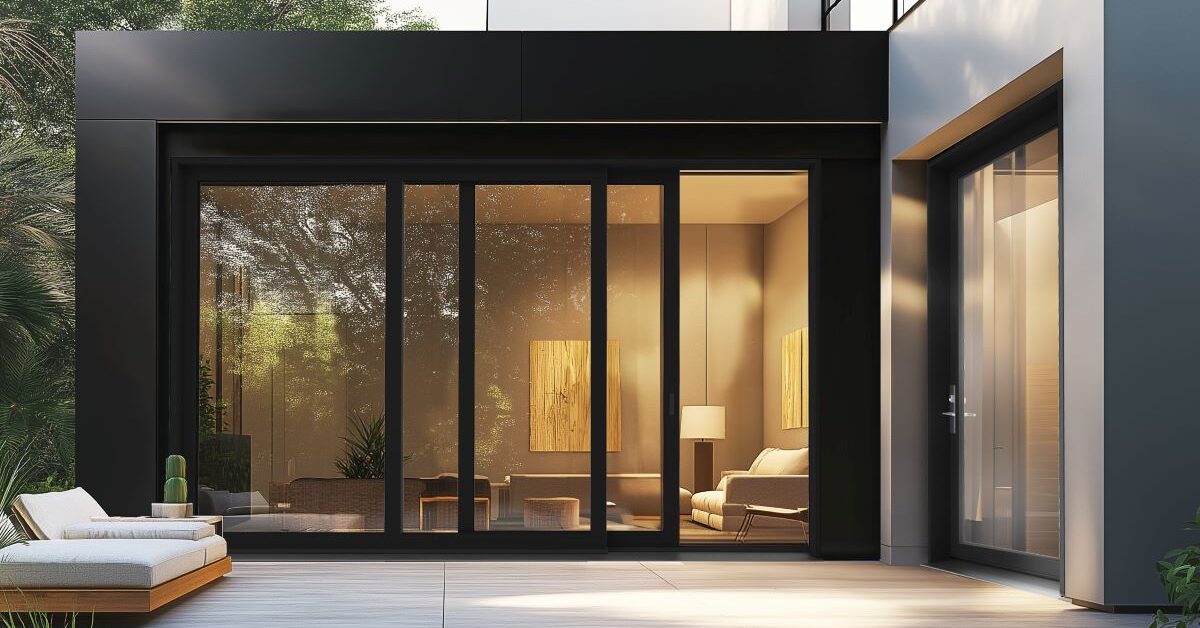No. 1 Thing to Consider When Selecting a Patio Door
Patio doors are more than just entryways; they’re the key to creating a seamless flow between your indoor and outdoor spaces. When it comes to selecting the right one, material choice is pivotal as different materials offer unique advantages. Let’s dive into details and consider all pros and cons of fiberglass versus other materials.
First, let’s consider vinyl
Pros:
- Price: Known for their durability and low maintenance, vinyl doors are an excellent choice for homeowners who are looking for cost-effective options.
- Maintenance: Resistant to rust and corrosion.
- Design: Available in a variety of colors and finishes.
- Energy Efficiency: Energy-efficient, helping to maintain indoor temperature and reduce energy costs.
Cons:
- Beauty: Less visually appealing than other materials with a high-end aesthetic like fiberglass, wood or aluminum.
- Durability: Prone to fading or discoloration over time when exposed to harsh sunlight.
Now, let’s look at aluminum
Pros:
- Beauty: Aluminum’s malleability allows for sleek, modern designs. It can be customized to fit various architectural styles and personal preferences, offering a wide range of colors and finishes.
- Energy Efficiency: With advanced thermal break technology, aluminum patio doors can significantly reduce heat transfer, helping maintain indoor temperatures and lowering energy bills.
- Maintenance: Unlike wood, aluminum doesn’t require regular painting or staining. It’s easy to clean and maintain, saving homeowners time and effort.
Cons:
- Price: Aluminum patio doors can be more expensive than other materials like vinyl or wood, which might be a consideration for budget-conscious buyers.
- Durability: While aluminum is durable, it can dent or scratch more easily than other materials. This could affect the appearance over time, especially in high-traffic areas.
Next, let’s look at wood
Pros:
- Beauty: Wood patio doors offer an unparalleled natural aesthetic that adds warmth and elegance to any home. The rich grains of wood create a timeless and inviting appeal.
- Energy Efficiency: Wood is a natural insulator, providing excellent thermal performance. Wood patio doors can help maintain comfortable indoor temperatures, reducing energy costs.
- Durability: With proper care and maintenance, wood patio doors can last for many years. High-quality wood can withstand the test of time and various weather conditions.
Cons:
- Maintenance: Wood patio doors require regular maintenance, including painting or staining, to protect them from the elements and maintain their appearance.
- Price: High-quality wood patio doors can be more expensive than alternatives like vinyl or aluminum. The initial investment and ongoing maintenance costs can add up over time.
- Performance: Wood patio doors are typically heavier than those made from other materials, which may require a more robust frame and hardware to support them.
- Energy Efficiency: While wood has good insulation properties, it may not perform as well as some advanced materials that are specifically engineered for energy efficiency, unless combined with modern glazing technologies.
Lastly, let’s look at fiberglass
Pros:
- Durability: Offers superior durability and can withstand harsh weather conditions better than vinyl. Highly resistant to dents, scratches and warping, making them a long-lasting option.
- Beauty: Can be designed to mimic the appearance of wood, combining aesthetics with strength. Available in smooth or woodgrain and various colors.
- Energy Efficiency: Energy-efficient, helping to maintain indoor temperature and reduce energy costs. They offer the best insulation properties and a longer lifespan than vinyl, wood or aluminum.
- Performance: Despite their strength, fiberglass doors are relatively lightweight, making them easier to install and less demanding on the framing and hardware.
- Maintenance: Fiberglass doors retain their color well, even with prolonged exposure to sunlight. This reduces the need for frequent refinishing and keeps your doors looking new for longer.
Cons:
- Price: More expensive upfront compared to vinyl or aluminum options which may deter budget-conscious buyers.
“What does pultruded mean?”
When discussing fiberglass material for patio doors, pultrusion cannot be overlooked, as it significantly impacts the structure of fiberglass doors.
Pultrusion is a manufacturing process used to create high-strength, lightweight fiberglass profiles. The process begins by pulling fiberglass strands through a resin bath and then through a heated die. It produces durable, corrosion-resistant door frames that maintain structural integrity over time. This results in patio doors that offer exceptional thermal performance, minimal maintenance and the ability to support expansive glass panels, making them ideal for modern architectural designs.
Don’t forget to ask whether your fiberglass patio door is a fully constructed pultruded fiberglass door.

GET IDEAS: MASTERGRAIN FC Patio Door Collection
Picking the perfect patio door material means finding the right mix of looks, durability and energy efficiency to fit your home. Whether you go with the timeless charm of wood, tough-as-nails fiberglass or the low up-keep of vinyl and aluminum, each choice has its perks. Think about your climate, budget and style preferences to make the best call. With a clear idea of the pros and cons, you’ll end up with a patio door that not only looks good but also stands up to wear and tear while keeping your home comfy.
Reach out to your MASTERGRAIN Dealer in Canada or visit the MASTERGRAIN Door Gallery in Vaughan for more details.
